In Russia and Europe, there are different types of pond snails. Among them, the largest is the common pond snail, the shell of which can reach 7 centimeters. All species breathe with lungs, therefore, from time to time they are forced to swim to the surface. You can often observe how the pond snail, the photo of which is presented in this article, slides smoothly and slowly along the lower part of the surface water film, picking up oxygen from the air.
If the mollusks, “suspended” in this way, are somehow disturbed, they immediately release an air bubble from the respiratory hole and fall like a stone to the bottom. The eared pond snail is the closest relative of the common one. Its shell reaches 2.5 centimeters, which depends on the abundance of food and the temperature in its reservoir.
The common pond snail and other species of its family (in addition to those listed above, in our reservoirs you can find ovoid, small and marsh) are very variable. In this case, the shapes, sizes, thickness of the shell, color of the body and legs of snails vary. Along with those that have a strong shell, there are species with a very fragile, thin shell that breaks even with the slightest pressure. There can also be various forms of a curl and mouth. The color of the body and legs varies from sandy yellow to blue-black.
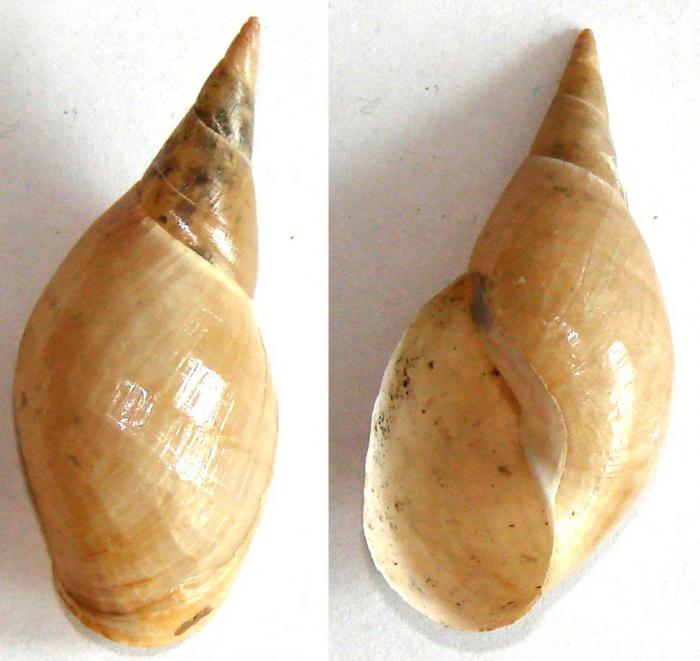
Structure
The body of the mollusk is enclosed in a spirally twisted shell, which has a mouth and a sharp top. The shell of the common pond snail is covered with a lime layer of a horn-like greenish-brown substance. It is a reliable protection of his soft body.
In the body of a snail, 3 main parts can be distinguished: the leg, head and body - although there are no sharp boundaries between them. Only the front part of the body, leg and head can protrude from the shell through the mouth. The leg is very muscular. It occupies the abdominal area. Such snails are called gastropods. At the same time, sliding on objects with the sole of the foot or hanging to the lower film of water, the mollusk smoothly moves forward.
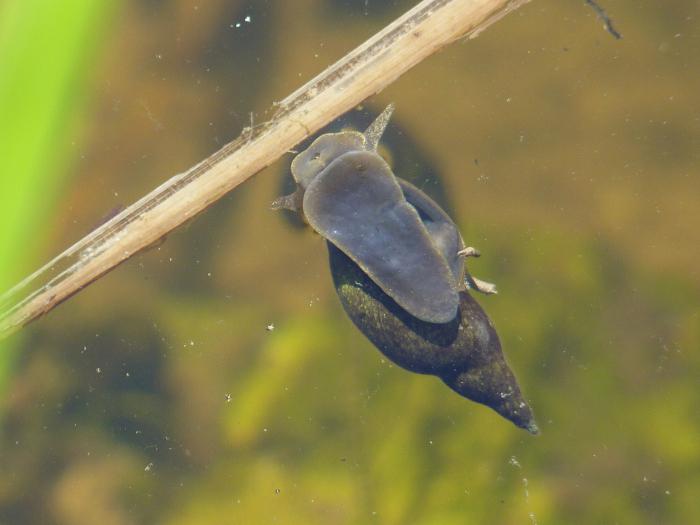
The body at the same time copies the shape of the shell, adjoining it very closely. It is covered in the front part by a mantle (a special fold). The space between it and the body is called the mantle cavity. The torso in front passes into the head, which has a mouth on the underside, and two sensitive tentacles on the sides. A pond snail, when lightly touched, instantly draws its leg and head into the shell. Near the bases of the tentacles there is one eye each.
Circulation
The common pond structure has a rather interesting structure. So, he has a heart, which pushes the blood into the vessels. In this case, large vessels are subdivided into small ones. And from them already the blood goes into the gaps between the organs. Such a system is called "unclosed". Interestingly, the blood washes each of the organs. Then she again gathers in the vessels that lead to the lung, after which she goes directly to the heart. In such a system, it is much more difficult to ensure the movement of blood than in a closed one, since it slows down between organs.
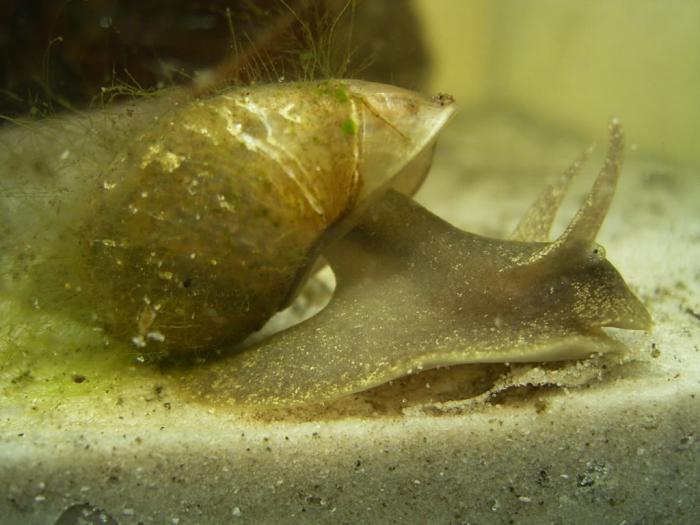
Breath
Despite the fact that the snail lives in water, it breathes atmospheric air. To do this, the common pond snail, the structure of which is described in this article, floats to the surface of the reservoir and opens a round breathing hole at the edge of the shell. It leads to the lung - a special pocket of the mantle. The walls of the lung are densely braided. In this place, carbon dioxide is released and the blood is enriched with oxygen.
Nervous system
This mollusk has a near-pharyngeal concentration. From them, the nerves extend to all organs.
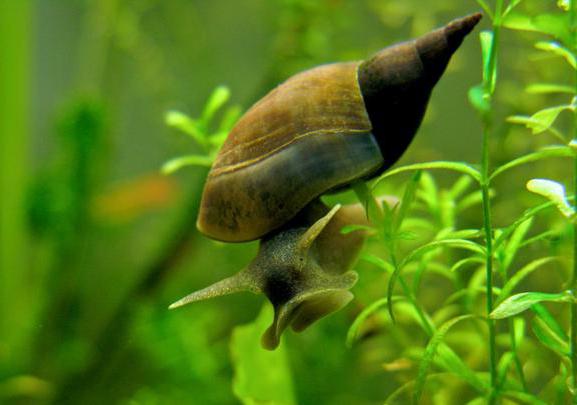
Nutrition
The snail's mouth leads to the pharynx. There is a muscular tongue covered with teeth ─ the so-called grater. The common pond snail, the photo of which can be viewed in this article, scrapes off plaque from all kinds of microorganisms that form on various underwater objects, and also rubs various parts of plants. Food from the pharynx travels to the stomach and then to the intestines. The liver also aids in its digestion. In this case, the intestine opens with an anus into the cavity of the mantle.
movements
If the caught pond snail is put in a jar, it immediately begins to actively crawl along its walls. At the same time, a wide leg extends from the shell opening, which serves for crawling, as well as a head with two long tentacles. By sticking the sole of the foot to various objects, the snail glides forward. In this case, sliding is achieved by wave-like, smooth contractions of the muscles, which can be easily observed through the glass of the vessel. Interestingly, the common pond snail can wander along the lower surface of the water, as we have already discussed above. At the same time, it leaves a thin tape of mucus. It stretches across the surface of the water. It is believed that snails moving in this way use liquids, hanging from below to an elastic film that forms on the surface due to this tension.
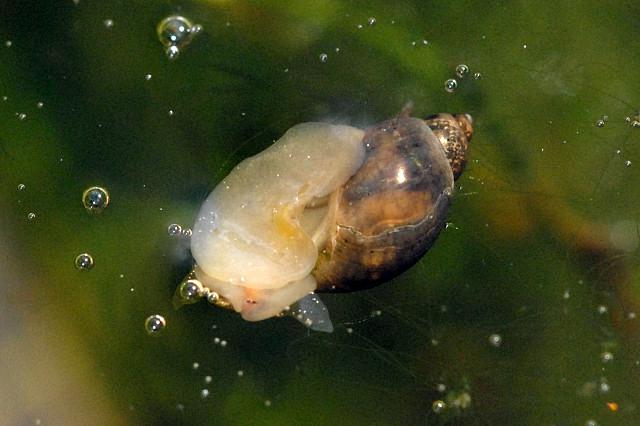
Such crawling can be easily observed on the calm surface of the reservoir, going on an excursion or relaxing in nature.
If the pond mollusk, crawling in this way, again plunges into the water under a little pressure, it will be seen how it again, like a cork, rises to the surface. This phenomenon is easily explained: there is air inside the respiratory cavity. He supports the cochlea as the Prudovik can compress his respiratory cavity arbitrarily. In this case, the mollusk becomes heavier, therefore, sinks to the very bottom. But when the cavity expands, it floats to the surface along a vertical line without any push.
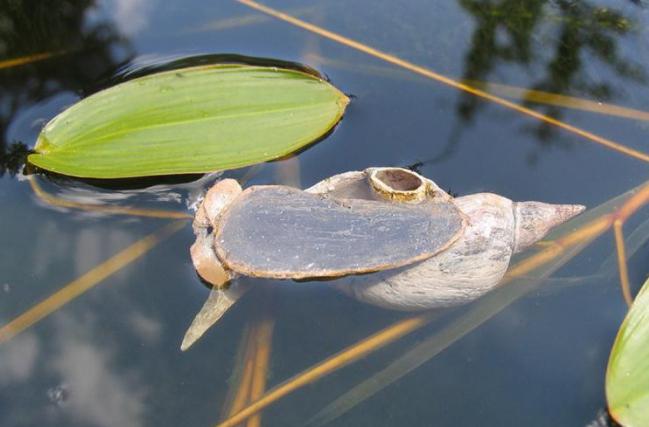
Try to immerse a pond snail floating on the surface of a reservoir in water and disturb its soft body with a touch of tweezers or a stick. The leg will immediately pull back into the shell, and air bubbles will come out through the breathing hole. Further, the mollusk will fall to the bottom and will not be able to independently rise to the surface in any other way than climbing on plants, due to the loss of the air float.
reproduction
The pond snail mollusk is a hermaphrodite, although its fertilization is cross. The snail lays eggs that are enclosed in slimy, transparent cords attached to algae. Eggs hatch into small pond snails with very thin shells.
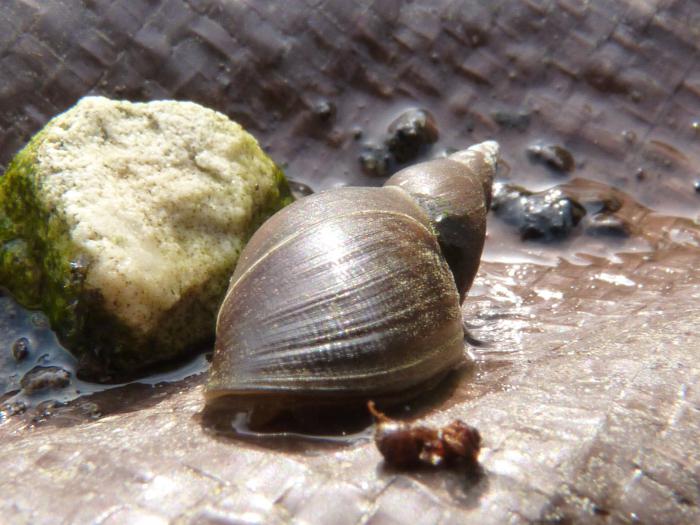
If you still decide to start an ordinary pond snail, then you need to understand that a water temperature of about 22 ˚С and its moderate hardness are considered a prerequisite for its maintenance.
